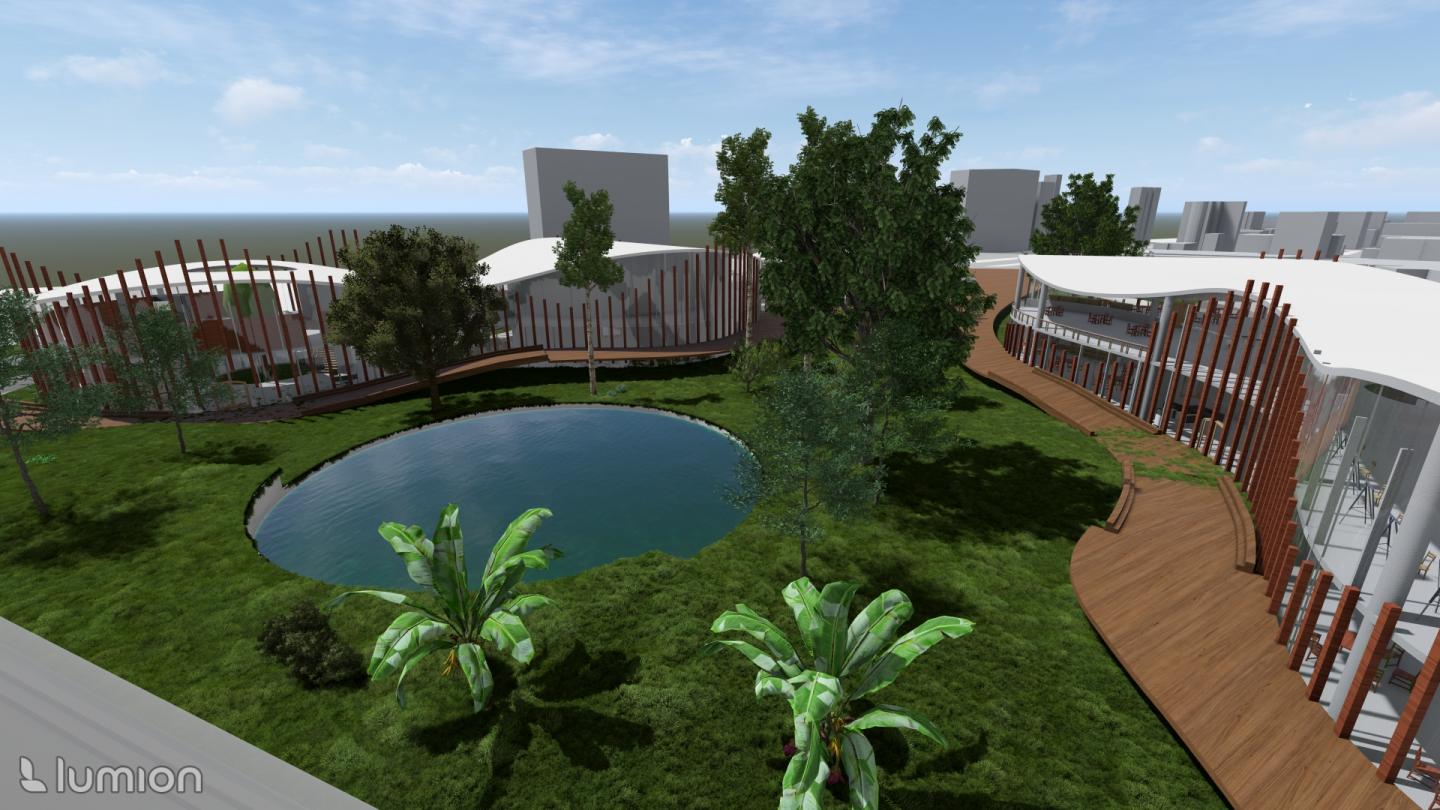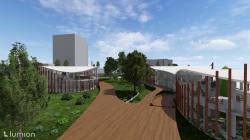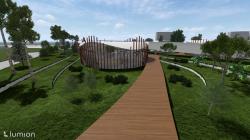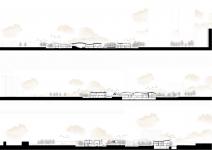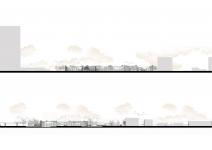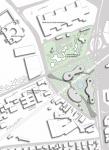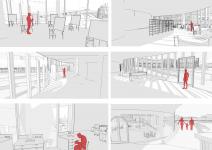POLIFAUNA CENTER
“An Urban Ecosystem at the Intersection of Density and Nature”
The expanding fabric of cities increasingly restricts our contact with nature; for individuals walking through concrete streets, nature has become less of an “encounter” and more of a “search.” This shift has led to perceiving access to nature not as a universal right, but as a privilege—especially for children, many of whom spend large portions of their lives disconnected from the natural world. It is precisely at this juncture that the Polifauna Center proposes itself as a hybrid space where urban dwellers can maintain and renew their relationship with nature: a place to learn, to experience, and to observe. The project is a spatial realization of the emotional and cognitive bond between humans and the living environment.
Ecological Intervention within the City The potential of neglected urban gaps often goes unnoticed. Yet these pockets represent critical thresholds where urban ecosystems can be reknit. Situated around İzmir’s Stadium Metro—a node of intense pedestrian traffic—the Polifauna Center opens a window onto nature. Rather than simply serving as a thoroughfare, this site offers a pause: a place to notice, to rest, to observe, and perhaps to linger. In doing so, it embodies the idea of permeability between city and nature.
Ecologically Informed Design Decisions Throughout the project, decisions have been guided not just by aesthetics but by principles of ecological sustainability. Rather than romanticizing nature, the design exposes its processes, cycles, and collaborative networks. In this spirit:
Circuit of Encounter: A meandering promenade brings people into contact with pollinators and plant communities at carefully chosen nodes, creating a journey of discovery and reflection.
Habitat Restoration: Beyond architecture, the project acts as a habitat repair initiative, improving local ecological conditions.
Layered Programs: The plan interweaves public realm, research labs, creative workshops, and event spaces into an open, inclusive arrangement.
What Is a Pollinator Garden?
At the heart of Polifauna lies the Pollinator Garden. Pollinators—bees, butterflies, insects, and birds—are the unsung heroes of plant reproduction, yet their habitats shrink daily in urban areas. Pollinator Gardens are specialized landscapes designed to support these species and preserve biodiversity within the city.
These gardens are not only ecologically vital; they are also educational and transformative environments. They reveal the hidden choreography of nature’s cooperation and provide a living classroom for understanding life’s cyclical rhythms.
Key Features:
Native and regionally adapted plant species rich in nectar and pollen (e.g., sage, thyme, lavender, rosemary, chamomile, mint).
Zero use of harmful chemicals or synthetic fertilizers.
Selection of drought-tolerant plants to minimize water consumption.
Design that promotes ecological balance and low-maintenance.
Dense flowering sequences to ensure continuous habitat and food sources.
Pollinators and the Ecosystem of Cooperation Pollinators do more than transfer pollen—they anchor the web of life. Without them, agricultural yields decline, plant populations falter, and ecological cycles break down. Pollinator Gardens serve as quiet stages where this invisible labor becomes visible, demonstrating how sensitive design can welcome and celebrate small creatures.
Visitors here gain not only aesthetic pleasure but also curiosity and responsibility. Watching a bee land on a flower is witnessing a life cycle in motion—an act of silent education, meditation, and empathy.
Visitor Experience and Circulation Strategy The visitor’s journey at Polifauna goes beyond the physical: it is emotional and intellectual. The sinuous boardwalk replaces aimless strolls with purposeful exploration. At times, one encounters an interpretive panel; at others, the hum of a workshop in progress. This spatial continuity mirrors nature’s own rhythm of change and renewal.
Slowed Movement: The winding path naturally slows visitors, giving them time to pause and observe.
Visual Vignettes: Lookout points, insect observation stations, nesting boxes, and clustered plantings are positioned to create moments of discovery.
Participatory Route: Guests are invited not merely to watch but to become active participants—learners, creators, and co-observers.
Social Impact and Collective Memory Polifauna is more than a park—it is an open campus of environmental learning and shared heritage. It offers spaces for children’s nature education programs, university research initiatives, and artists inspired by the living world. By fostering ecological literacy, it helps catalyze broader social change. A sustainable future depends not only on technology but on a collective awareness of our ties to the environment. Polifauna plants that seed of consciousness in the urban community.
Project Program and Spatial Organization Functions are organized around the central boardwalk into three main axes:
Research Hub: Underneath the metro viaduct, a glass-enclosed pavilion provides an acoustically buffered environment for fauna studies. Inside, one finds research laboratories, monitoring stations, and informational displays. Conservation clubs and educational groups will use this facility as their field base.
Workshop Zone: Focused on hands‑on learning, this area includes:
Nature Photography Studio
Natural Material Craft Workshop
Botanical Dyeing and Textile Studio
Bio‑demonstration Training Lab
Children’s Nature Education Space
Event & Community Area: An exhibition gallery for workshop outputs, seminar rooms, temporary market stalls, and outdoor event lawns. A café provides a social meeting point, blending refreshment with ecological ambiance.
Architectural Approach and Formal Language
The buildings draw inspiration from organic forms. The boardwalk undulates like a living organism, linking dispersed functions into a coherent route that follows the site’s topography. Structures sit lightly on the earth, employing lightweight, transparent frameworks that echo natural patterns. Raised platforms lift the architecture from the ground, fostering a seamless dialogue between interior and landscape.
Spatial Dialogue with Nature
Architecture here is more than functional—it is a multisensory, cultural encounter. Nature is not a framed view or an ornament but an active partner in the design process. Wind corridors, pollinator flight paths, bird perching sites, and solar orientation all inform the shape and orientation of the built elements. This attentive approach invites visitors into a more mindful, slower-paced relationship with both nature and architecture.
Moreover, the subtle rustle of leaves guides circulation routes, while dappled sunlight filters through living canopies to enliven interior spaces. Textured surfaces—wood grains warmed by the sun, stone edges softened by moss—encourage touch and discovery. Seasonal breezes carry the scent of flowering shrubs into shaded alcoves, and strategically placed water features amplify ambient soundscapes. Together, these sensory cues orchestrate a dialogue in which the building itself becomes a responsive participant in the surrounding ecosystem.
A Growing Ecosystem Over Time
Polifauna Center is not a static structure but a living organism that unfolds over time, shifts with the seasons, and transforms alongside its inhabitants. Each year, a different flower blooms, a new bird species appears, or the pollinator population swells—testifying to an architecture that speaks a language evolving in harmony with nature.
Over successive seasons, the landscape’s palette changes: spring’s pastel blossoms give way to summer’s vibrant hues, autumn’s russet tones, and winter’s subtle evergreens. These cyclical transitions are intentionally highlighted through plantings grouped by bloom calendar, so visitors experience fresh colors and fragrances on every visit. As native grasses and wildflowers reseed themselves, pathways softly realign with shifting plant masses, prompting minor adjustments in circulation that encourage exploration of newly opened vistas.
Simultaneously, built elements respond: modular decking panels can be reconfigured, vine-covered pergolas expand or contract, and pollinator hotels are relocated each year to optimize habitat. Sensors embedded in planters monitor soil moisture and biodiversity indices, informing curators when to introduce new species or adapt irrigation schedules—creating a feedback loop between human caretakers and the living system.
Community participation deepens this evolution: local schools collect seasonal data, citizen-scientists ring-tag butterflies, and artists record the site’s annual metamorphoses through interactive installations. Over time, Polifauna becomes not merely a place to observe nature but a collaborative laboratory, where architecture adapts, inhabitants thrive, and a culturally rich narrative of ecological resilience unfolds.
Sustainability and Ecological Balance
Polifauna exemplifies sustainable living within the city, guided by these principles:
Prioritizing native planting to reduce irrigation demands.
Embracing natural cycles without synthetic inputs.
Designing slow‑flow pathways that encourage reflection.
Selecting low‑impact materials—local timber, natural stone, and permeable surfaces.
Materials and Construction Strategies Every structural decision aims to minimize carbon footprint and maximize ecological sensitivity:
Local wood sourced from certified forests, valorizing carbon sequestration.
Roof membranes of polycarbonate and technical textiles that diffuse daylight.
Permeable paving with stone aggregates for groundwater recharge and rainwater harvesting.
Plant palette of indigenous species, serviced by an integrated greywater irrigation system.
Nature as the Silent Teacher In this project, nature is not decoration but the primary instructor. Polifauna invites visitors to experience the environment as an intrinsic component of the architecture—like a poem whose meaning deepens with every reading and whose impact endures over time. It cultivates individual awareness while modeling a productive, nature‑friendly urban paradigm.
Conclusion
Polifauna Center is an ode to remembrance—a quiet narrative of nature amid the dominance of concrete, speed, and noise. The simple act of watching a bee land on a flower, a child feeling soil in her hands for the first time, or a commuter stepping off the metro into a living landscape—all become tangible moments in the project’s envisioned transformation.
This is not merely a center but a starting point—an initial step toward opening new pockets of nature throughout the city. Polifauna does more than reshape a site; it reshapes perspectives.
2025
Archicad, lumion and photoshop were used.
AYŞE DİLAN USLU
Favorited 1 times
